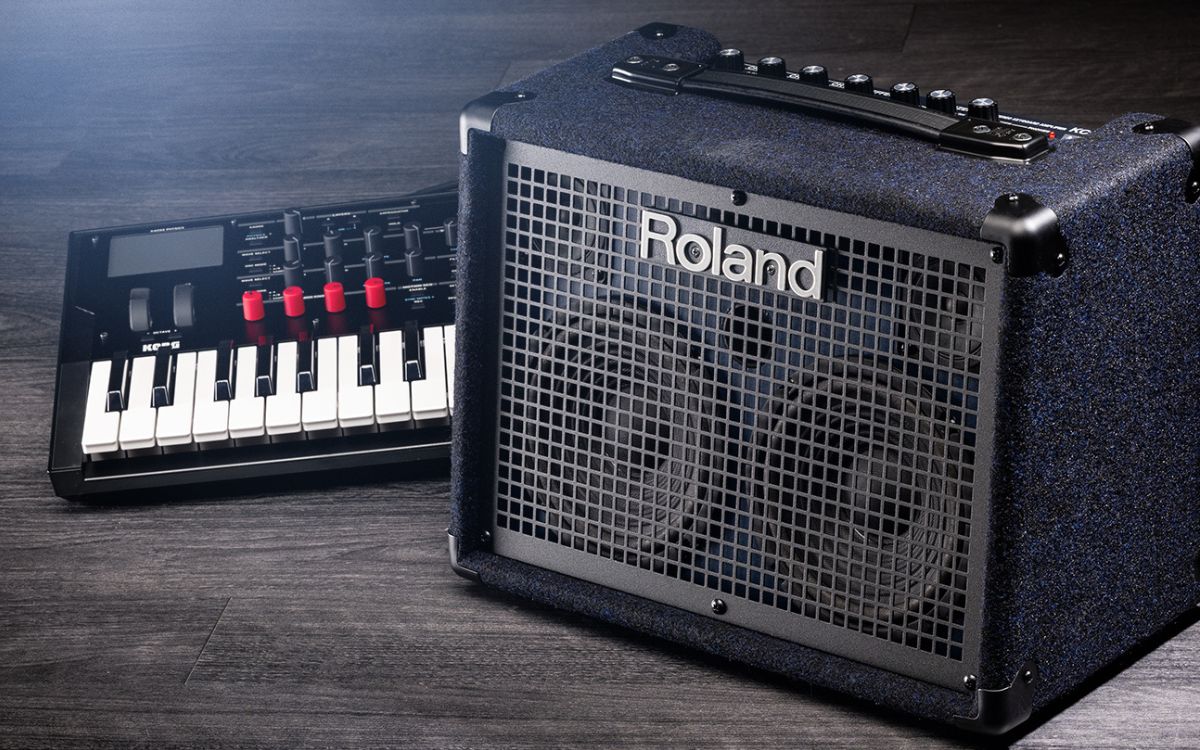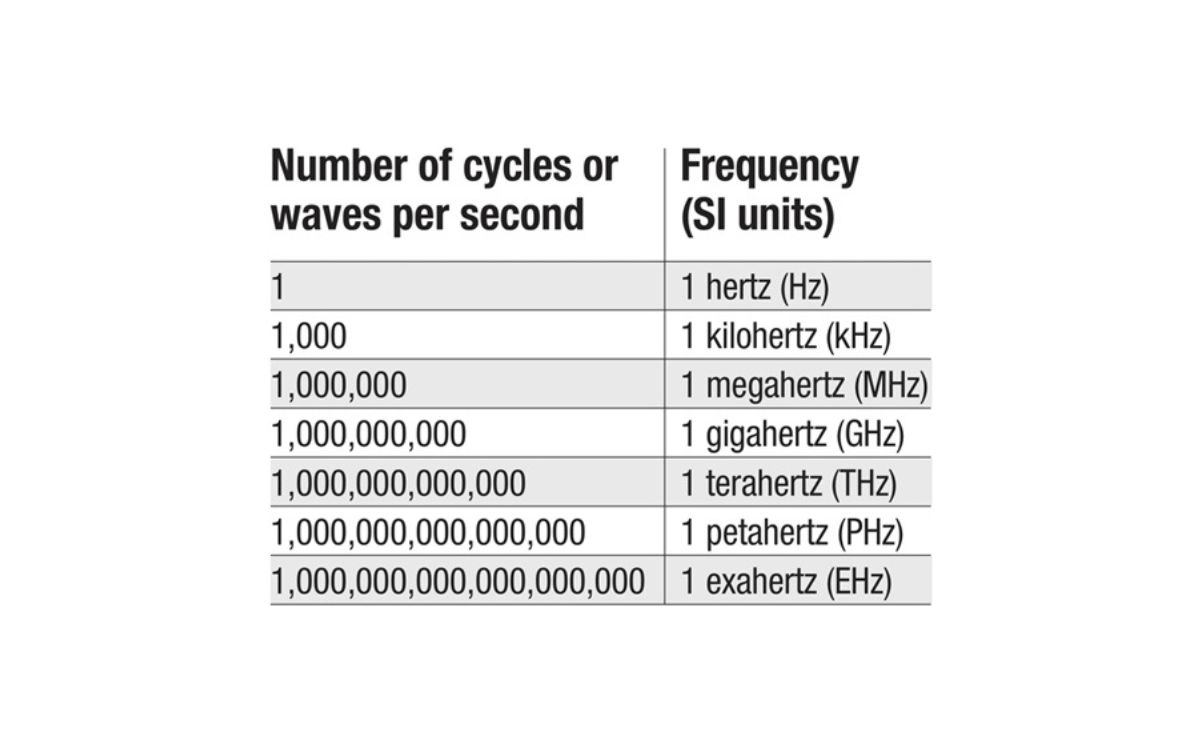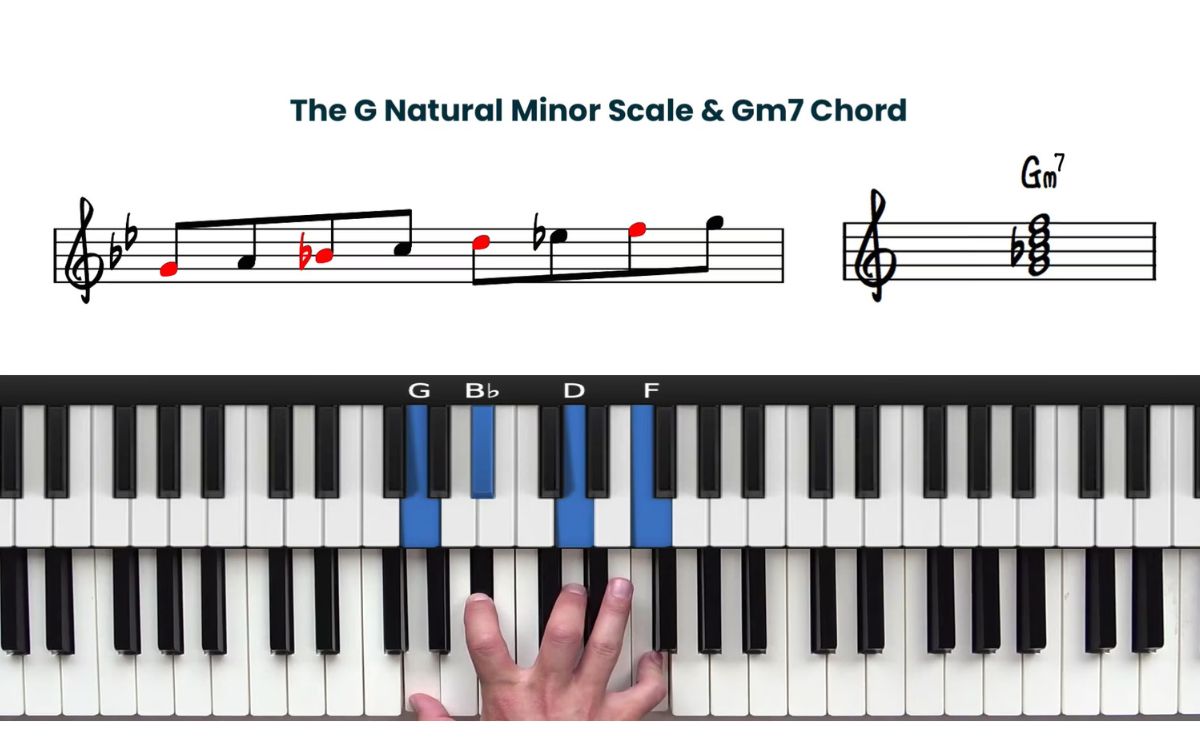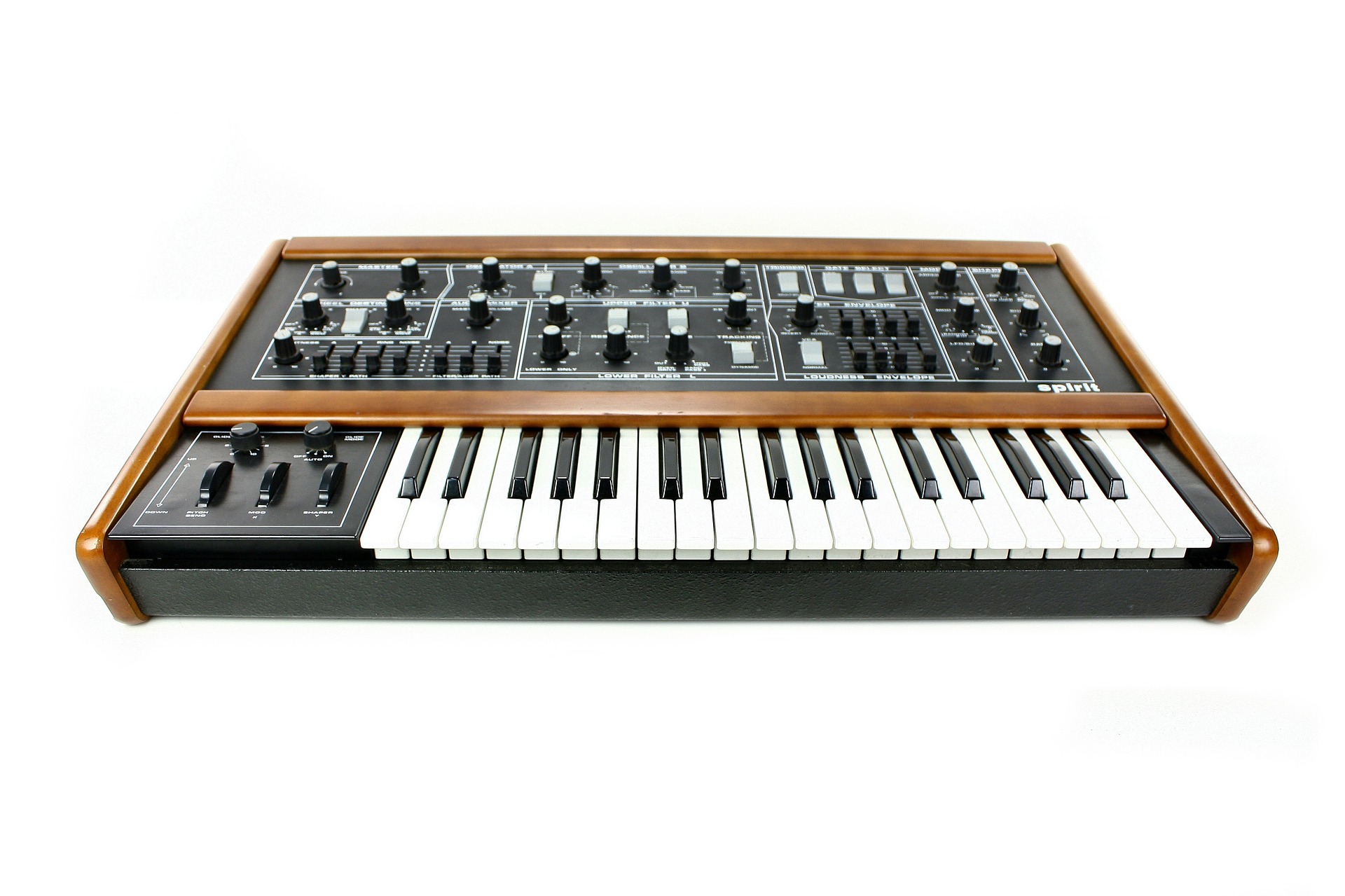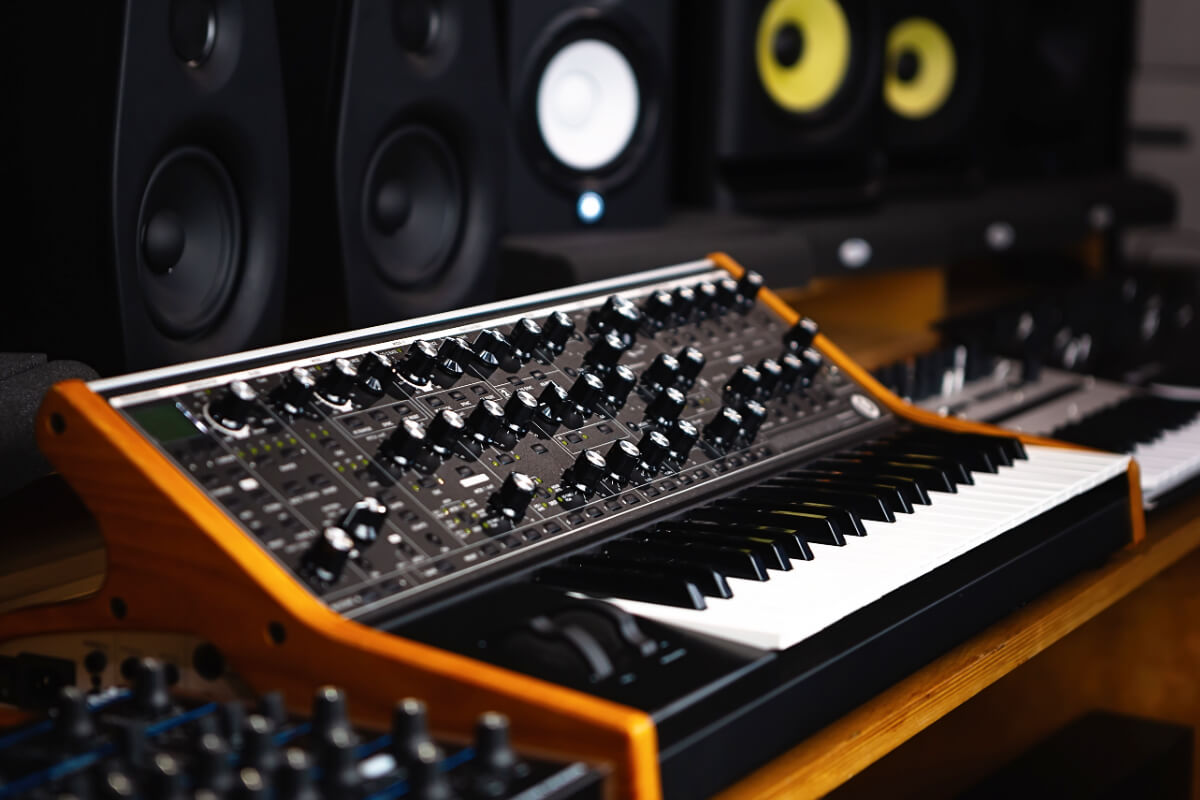Home>Instruments>Synthesizer>What Is Analog Synthesizer
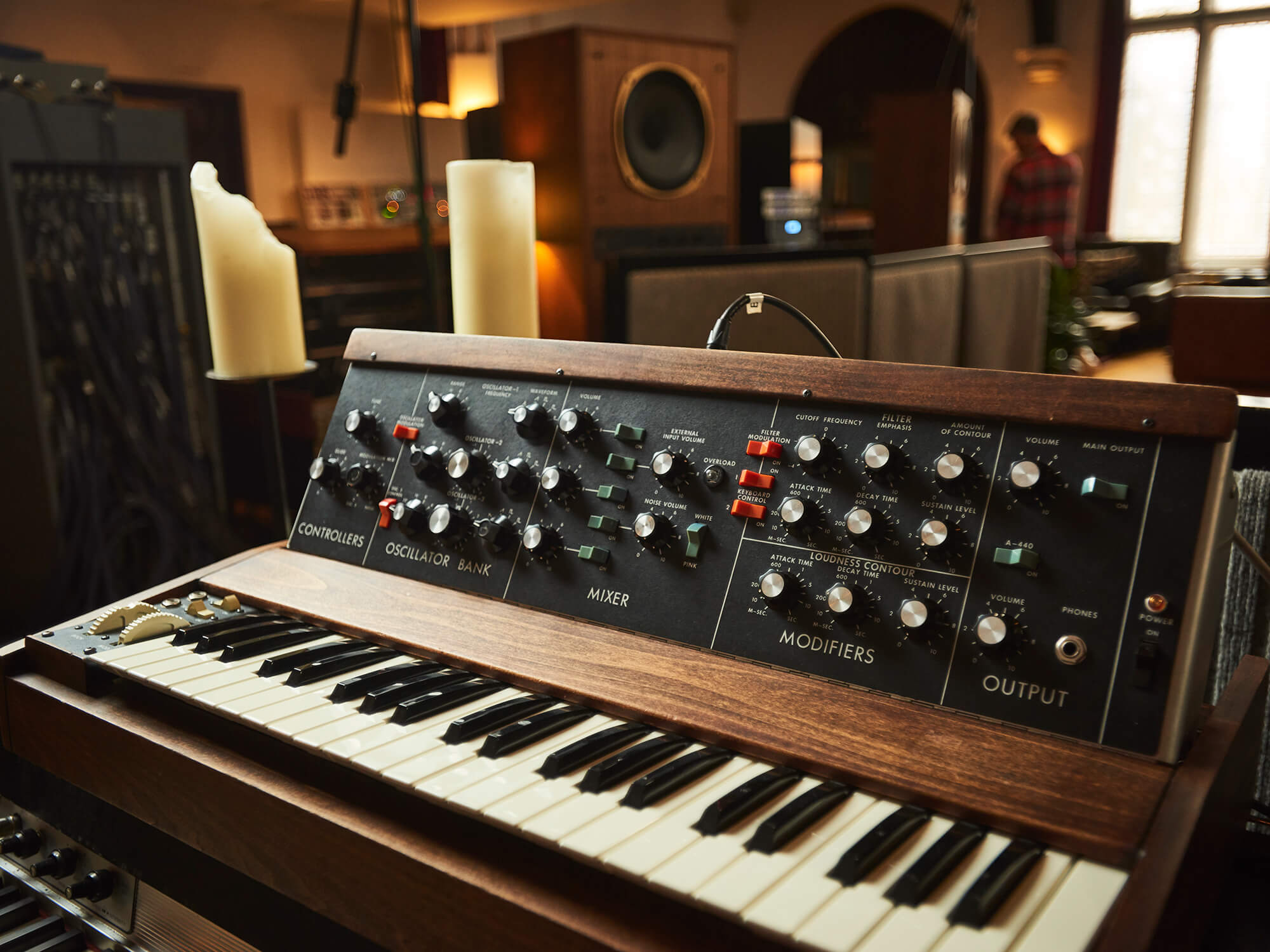

Synthesizer
What Is Analog Synthesizer
Published: December 11, 2023
Discover the fascinating world of analog synthesizers with our comprehensive guide. Learn what a synthesizer is, how it works, and why it is essential for creating unique and innovative sounds.
(Many of the links in this article redirect to a specific reviewed product. Your purchase of these products through affiliate links helps to generate commission for AudioLover.com, at no extra cost. Learn more)
Table of Contents
- Introduction
- History of Analog Synthesizers
- Basic Components of an Analog Synthesizer
- Signal Flow in an Analog Synthesizer
- Voltage-Controlled Oscillators (VCOs)
- Voltage-Controlled Filters (VCFs)
- Envelope Generators (EGs)
- Voltage-Controlled Amplifiers (VCAs)
- Modulation Sources and Destinations
- Patching and Signal Routing in Analog Synthesizers
- Popular Analog Synthesizer Models
- Advantages and Disadvantages of Analog Synthesizers
- Conclusion
Introduction
Music has the power to stir our emotions, transport us to different worlds, and communicate the depths of the human experience. At the heart of creating captivating music lies the art of sound synthesis. Among the various technologies and methods for sound synthesis, the analog synthesizer stands as a celebrated icon.
An analog synthesizer is a musical instrument that generates sound by manipulating electronic signals in an analog circuitry. Unlike its digital counterpart, which uses binary code to recreate sound waveforms, an analog synthesizer employs electrical voltage to shape and modulate raw waveforms, resulting in a rich and organic sonic palette.
Since the dawn of electronic music, starting in the mid-20th century, analog synthesizers have played a significant role in shaping the landscape of modern music. From the pioneering works of electronic music composers like Wendy Carlos and Kraftwerk to the iconic sounds of bands like Pink Floyd and The Beatles, the analog synthesizer has left an indelible mark on the music industry.
With their unique ability to produce warm, rich, and often unpredictable sounds, analog synthesizers have captured the hearts of musicians, producers, and synth enthusiasts alike. Whether used for creating otherworldly textures, fat basslines, soaring leads, or intricate soundscapes, these instruments offer a sonic playground limited only by the imagination of the user.
As technology has advanced, digital synthesizers have emerged, offering greater precision and convenience. However, the allure of analog synthesizers remains strong. Many musicians and producers appreciate the hands-on control, the tactile experience of turning knobs and patching cables, and the inherent imperfections and character that analog circuitry imparts to the sound.
In this article, we will dive into the captivating world of analog synthesizers. We will explore the history, components, signal flow, and patching techniques used in these instruments. We will also discuss popular analog synthesizer models and weigh the advantages and disadvantages of using analog synthesizers in the digital age.
So, whether you are a seasoned synth aficionado or just starting your journey into the world of sound synthesis, get ready to embark on an exciting sonic adventure as we unravel the mysteries of analog synthesizers.
History of Analog Synthesizers
The history of analog synthesizers dates back to the early 20th century when inventors and musicians began exploring the possibilities of generating electronic sound. However, it was not until the 1960s that the first commercially available analog synthesizers emerged, revolutionizing the music industry.
One of the most influential figures in the development of analog synthesizers was Dr. Robert Moog. In the 1960s, Moog introduced the Moog Modular Synthesizer, a massive system consisting of various modules that could be interconnected to create a wide range of sounds. It quickly gained popularity among musicians and composers, setting the stage for the widespread adoption of analog synthesis.
During the 1970s and 1980s, several other notable companies, such as ARP, Oberheim, and Sequential Circuits, entered the market, further expanding the range of options for musicians. These synthesizers became a staple in the music scene, fueling the creativity of artists and birthing new genres, including electronic and synth-pop.
However, with the advent of digital technology in the 1980s, analog synthesizers faced stiff competition. Digital synthesizers offered greater precision, programmability, and affordability, leading to a decline in the popularity of analog instruments. Many manufacturers shifted their focus to digital synthesizers, while others closed their doors.
Despite this shift, there was a resurgence of interest in analog synthesizers in the late 1990s and early 2000s. Musicians and producers began to appreciate the unique warmth, character, and hands-on nature of analog instruments. This resurgence paved the way for the emergence of boutique and modular synthesizer brands, catering to the demand for analog sound and craftsmanship.
Today, analog synthesizers continue to thrive, with a wide range of options available to musicians and producers. Iconic models like the Moog Minimoog, ARP 2600, and Roland Jupiter-8 have become sought-after classics, while new and innovative designs from companies like Dave Smith Instruments and Elektron offer exciting possibilities.
The evolution of analog synthesizers has had a profound impact on the music industry, influencing the sounds of countless genres, from ambient and experimental to techno and beyond. With their timeless appeal, analog synthesizers continue to shape the landscape of modern music, inspiring new generations of musicians and pushing the boundaries of sonic exploration.
Basic Components of an Analog Synthesizer
To understand how an analog synthesizer works, it is essential to familiarize yourself with its basic components. These components work together to generate and shape sound, allowing for endless sonic possibilities. Here are the key elements found in most analog synthesizers:
- Voltage-Controlled Oscillators (VCOs): These are the sound generators of an analog synthesizer. VCOs produce waveforms such as sine, square, triangle, and sawtooth. They can be tuned to different frequencies and often feature controls for waveform shaping and modulation.
- Voltage-Controlled Filters (VCFs): VCFs shape the timbre of the sound by attenuating or boosting specific frequency ranges. Common types of analog filters include low-pass, high-pass, band-pass, and notch filters. They are responsible for creating the iconic sound textures associated with analog synthesizers.
- Envelope Generators (EGs): EGs shape the amplitude of a sound over time. They typically consist of four stages: attack, decay, sustain, and release. By adjusting the parameters of each stage, EGs control how quickly or slowly a sound fades in, sustains, and fades out.
- Voltage-Controlled Amplifiers (VCAs): VCAs control the volume of the sound. They are often paired with envelope generators to shape the overall dynamics of the sound. VCAs modulate the amplitude of the audio signal based on control signals received from various sources.
- Modulation Sources and Destinations: Analog synthesizers feature various modulation sources, including LFOs (Low-Frequency Oscillators), which generate slow oscillations used to modulate parameters, and ADSR (Attack, Decay, Sustain, Release) envelopes. These modulation sources can be routed to different destinations, such as filter cutoff frequency, oscillator pitch, or oscillator waveform selection.
- Patching and Signal Routing: Analog synthesizers often provide patch points or a matrix where users can physically connect various modules together using patch cables. This allows for flexible signal routing and modulation possibilities, giving users full control over the sound generation process.
By manipulating the parameters and interactions of these components, musicians and sound designers can sculpt unique sounds and textures. The combination of oscillator waveforms, filter characteristics, envelope shapes, and modulation sources allows for a vast range of sonic expression, making each analog synthesizer a versatile instrument with its own distinctive sonic character.
Signal Flow in an Analog Synthesizer
Analog synthesizers have a specific signal flow that determines how the various components work together to generate and shape sound. Understanding the signal flow is crucial for designing and manipulating sounds effectively. Let’s explore the typical signal flow in an analog synthesizer:
1. Sound Generation: The process begins with the voltage-controlled oscillators (VCOs) that generate the initial sound waveforms. VCOs produce waveforms such as sine, square, triangle, and sawtooth. Users can adjust the frequency, waveform shape, and modulation of the VCOs to create different tones.
2. Pitch Control: The output of the VCOs is sent to the voltage-controlled filters (VCFs). The VCFs determine the frequency content of the sound by attenuating or boosting specific frequency ranges. The cutoff frequency of the VCFs can be controlled manually or modulated by other sources.
3. Amplitude Control: The signal then passes through the voltage-controlled amplifiers (VCAs). The VCAs control the overall volume or amplitude of the sound. They can be modulated by envelope generators (EGs), which shape the loudness of the sound over time, or other modulation sources such as LFOs.
4. Modulation: Analog synthesizers allow for extensive modulation capabilities. Various modulation sources, such as LFOs or envelope generators, can modulate parameters like the cutoff frequency of the VCF or the pitch of the VCO. This modulation adds movement, vibrato, rhythmic variations, and other dynamic elements to the sound.
5. Effects and Signal Processing: Some analog synthesizers include built-in effects or external processing options. These effects can include reverb, delay, distortion, and more. By applying these effects, you can further shape and enhance the sound produced by the synthesizer.
6. Output: Finally, the sound is sent to the output stage where it is amplified and sent to speakers or recorded into an audio interface for further processing or mixing.
It’s important to note that signal flow in analog synthesizers can vary between different models and manufacturers. Some synthesizers may feature additional modules or unique signal routing options. However, the general signal flow described above provides a foundational understanding of how the main components interact to shape the sound in an analog synthesizer.
Voltage-Controlled Oscillators (VCOs)
Voltage-Controlled Oscillators (VCOs) are the heart and soul of an analog synthesizer. These essential components generate the primary sound waveforms that serve as the foundation for creating a wide range of sounds. VCOs are responsible for producing waveforms such as sine, square, triangle, and sawtooth.
VCOs in analog synthesizers have several key features and controls that allow musicians and sound designers to shape the sound to their liking:
- Frequency Control: VCOs have a frequency control knob or input that determines the pitch or frequency of the generated waveform. By adjusting this control, users can create tones that span from deep bass frequencies to high-pitched leads.
- Waveform Selection: Analog synthesizers often provide options for selecting different waveform shapes. The most common waveforms include sine, square, triangle, and sawtooth. Each waveform has a distinct timbre and harmonics, offering versatility in sound design.
- Waveform Modulation: VCOs can be modulated to introduce dynamic changes to the waveform. This modulation can be achieved by routing control voltages from other sources, such as envelope generators or low-frequency oscillators (LFOs), to the VCO’s modulation input. This allows for effects like vibrato, frequency modulation (FM), or pulse width modulation (PWM).
- Octave and Fine-Tuning: VCOs often provide controls for octave shifting and fine-tuning the frequency. Octave controls allow for quickly transposing the VCO’s output up or down by one or more octaves. Fine-tuning controls provide precise adjustments to the frequency, allowing for more accurate tuning across the keyboard.
- Synchronization: Some VCOs feature synchronization capabilities, allowing them to sync to the frequency of another oscillator. This creates complex and harmonically rich sounds as the synchronized oscillators work together in lockstep.
VCOs are typically used in conjunction with other modules in the synthesizer, such as voltage-controlled filters (VCFs) and voltage-controlled amplifiers (VCAs). Through modulation and signal routing, VCOs contribute to the creation of evolving textures, harmonically rich timbres, and expressive musical performances.
With the advent of digital technology, virtual analog synthesizers have emulated the sounds and capabilities of analog VCOs with remarkable accuracy. However, the unique characteristics and imperfections of true analog VCOs, including drift, warmth, and organic variations, continue to make them highly sought after by musicians and enthusiasts.
Whether used to produce soaring leads, punchy basslines, or ethereal soundscapes, voltage-controlled oscillators form the backbone of analog synthesizers, providing endless sonic possibilities for musical expression.
Voltage-Controlled Filters (VCFs)
Voltage-Controlled Filters (VCFs) are integral components of analog synthesizers that shape the timbre and tone of the sound. These filters attenuate or boost specific frequencies, allowing users to sculpt the character of the sound generated by the voltage-controlled oscillators (VCOs). VCFs are responsible for the iconic and unique texture associated with analog synthesizers.
VCFs offer various filter types, each with its distinctive frequency response and sonic characteristics:
- Low-Pass Filter (LPF): LPF allows frequencies below a certain cutoff point to pass through while attenuating frequencies above it. This creates a warm and mellow tone. By adjusting the cutoff frequency, users can shape the brightness or darkness of the sound.
- High-Pass Filter (HPF): HPF allows frequencies above a cutoff point to pass while attenuating frequencies below it. This results in a brighter and more focused sound. HPFs are useful for removing low-end rumble and emphasizing the presence of higher frequencies.
- Band-Pass Filter (BPF): BPF allows a specific range of frequencies, known as the passband, to pass through while attenuating frequencies outside the passband. This filter type can create a narrow or wide frequency range with a distinct resonance or peak. BPFs are commonly used for adding emphasis to specific frequency bands, such as creating vocal-like sounds or emphasizing the presence of a particular instrument.
- Notch Filter: A notch filter, also known as a band-reject or band-stop filter, attenuates a specific range of frequencies while allowing others to pass through. Notch filters create a distinct “notch” shape in the frequency spectrum by eliminating or reducing a specific frequency or frequency range.
In addition to the filter type, VCFs often include controls for adjusting the cutoff frequency and resonance:
- Cutoff Frequency: The cutoff frequency determines the point at which the filter starts attenuating or boosting specific frequencies. Adjusting this control allows for precise frequency shaping, allowing users to create tonal variations and changes over time.
- Resonance: Resonance, also known as emphasis or Q, controls the intensity of frequencies near the cutoff point. Increasing the resonance can result in a more pronounced and emphasized frequency peak, adding a rich and resonant quality to the sound.
VCFs can be modulated by various sources, including envelope generators (EGs), low-frequency oscillators (LFOs), or even other VCOs. This modulation adds movement and dynamic changes to the timbre of the sound, allowing for evolving textures and expressive musical performances.
Voltage-Controlled Filters play a vital role in shaping the character and personality of analog synthesizers. They contribute to the sonic palette, allowing musicians and sound designers to explore a vast array of tonal possibilities and create everything from smooth and mellow pads to aggressive and biting leads.
Envelope Generators (EGs)
Envelope Generators (EGs) are essential components in analog synthesizers that shape the amplitude of a sound over time. EGs play a crucial role in creating dynamic and expressive sounds by defining how a sound evolves from when it is triggered to when it fades away. Commonly consisting of four stages – attack, decay, sustain, and release – EGs allow users to sculpt the volume contour of a sound.
Here’s a breakdown of each stage in an envelope generator:
- Attack: The attack stage is responsible for the time it takes for a sound to reach its maximum volume after it is triggered. Adjusting the attack control determines whether a sound fades in slowly or starts abruptly.
- Decay: After the sound reaches its maximum volume, it enters the decay stage, which defines how quickly it fades down to the sustain level. The decay control determines the duration of this stage.
- Sustain: The sound enters the sustain stage once the decay stage is complete. The sustain level represents the volume at which the sound stays as long as the key or trigger is held down. The sustain control allows users to set the desired volume level for this stage.
- Release: When the key or trigger is released, the sound enters the release stage. The release stage controls the time it takes for the sound to fade away completely. It determines the length of time it takes for the sound to return to silence after the key or trigger is released.
These stages of an EG can be adjusted manually or modulated using various control sources, such as a keyboard or an LFO. By modulating the parameters of an EG, users can create dynamic and evolving sounds.
EGs are commonly used to shape the amplitude of sounds, but they can also be employed to modulate other parameters in the synthesizer, such as the filter cutoff frequency or the pitch of the oscillator. By using EGs to control different aspects of the sound, musicians and sound designers can create intricate and evolving timbres.
The versatility of envelope generators allows for a wide range of sonic possibilities, from the sharp and punchy attacks of percussive sounds to the long and evolving pads of ambient textures. Whether adding expressiveness to a lead melody or creating rhythmic variations in a sequence, envelope generators are a fundamental tool for shaping and sculpting the dynamics of an analog synthesizer’s sound.
Voltage-Controlled Amplifiers (VCAs)
Voltage-Controlled Amplifiers (VCAs) are key components in analog synthesizers that control the volume or amplitude of a sound. VCAs manipulate the level of an audio signal based on control signals received from various sources, allowing for dynamic control and modulation of the sound’s intensity.
VCAs perform two primary functions:
Amplitude Control: The main purpose of a VCA is to adjust the volume or amplitude of a sound. The audio signal passes through the VCA, and its level is determined by the control voltage received at the VCA’s input. By manipulating this control voltage, users can raise or lower the volume of the sound.
Dynamic Modulation: VCAs are widely used for dynamic modulation of sound. The control signal that determines the amplification level can come from various sources, such as envelope generators (EGs) or low-frequency oscillators (LFOs). Modulating the VCA’s control input with an EG, for example, allows for shaping the sound’s amplitude over time, enabling expressive and evolving sound design.
VCAs commonly feature the following controls:
- Gain/Amplification: This control determines the amplification or attenuation applied to the audio signal passing through the VCA. It sets the initial volume level of the sound.
- Control Input: The control input of a VCA is where the modulation signal is connected. This input receives control voltages that dynamically adjust the amplification level. Common sources for control signals include EGs, LFOs, and even other audio signals.
- CV Scaling: Some VCAs provide a CV scaling control, allowing users to adjust the response of the control voltage and its effect on the VCA’s amplification. This control offers fine-tuning capabilities to match the desired modulation depth and response.
- Audio Inputs and Outputs: VCAs typically have audio input and output connections. The audio input is where the signal to be amplified or modulated is connected, while the audio output carries the resultant signal after the VCA’s amplification or attenuation.
By using VCAs in conjunction with other modules, such as VCOs or VCFs, sound designers can create complex and evolving sonic textures. VCAs provide control over the dynamics and intensity of the sound, allowing for expressive performances and precise manipulation of the audio signal.
Whether used for shaping the volume of individual notes or implementing amplitude modulation effects, VCAs are indispensable elements in analog synthesizers, enabling musicians and sound designers to shape the character and dynamics of their sounds with precision and creativity.
Modulation Sources and Destinations
Modulation is a crucial aspect of analog synthesizers that adds movement and sonic richness to the sound. Modulation sources generate control signals that can be assigned to various parameters within the synthesizer, known as modulation destinations. This modulation allows for dynamic changes and interactions between different elements of the sound. Let’s explore some common modulation sources and destinations:
Modulation Sources:
- Low-Frequency Oscillators (LFOs): LFOs generate slow oscillations below the audible range. LFOs are commonly used to modulate parameters such as pitch, filter cutoff frequency, and amplitude. They add rhythmic variations, vibrato, and tremolo effects to the sound.
- Envelope Generators (EGs): EGs produce control signals that shape the dynamics of a sound. They are often used to modulate parameters like filter cutoff frequency, oscillator pitch, or amplifier envelope level. EGs control the attack, decay, sustain, and release stages, allowing for expressive and intricate sound shaping.
- Sample and Hold: Sample and hold modules produce random voltages that can be used to modulate various parameters in a synthesizer. They introduce unpredictability and uniqueness to the sound, creating engaging and evolving textures.
- Key Tracking: Key tracking generates control signals that follow the pitch of the played note. This modulation allows for dynamic adjustments of parameters such as filter cutoff frequency or oscillator pitch in relation to the played note’s pitch.
- External Input: Some synthesizers feature external audio inputs that can be used as a modulation source. By routing an external audio signal, such as a drum loop or vocals, into the synthesizer, users can create interesting and complex modulation effects.
Modulation Destinations:
- Filter Cutoff Frequency: Modulating the cutoff frequency of a voltage-controlled filter (VCF) with an LFO or EG can create sweeping filter effects, adding movement and rhythmic variations to the sound.
- Oscillator Parameters: The pitch, waveform selection, or pulse width of VCOs can be modulated using various modulation sources. This modulation introduces dynamic changes to the musical content and timbre.
- Amplitude and VCA Level: Modulating the level of a VCA with an EG or LFO allows for dynamic volume changes. This modulation adds expressiveness and rhythmic variations to the sound.
- Effects Parameters: Some synthesizers include built-in effects or external effect send/return capabilities. Modulating the parameters of these effects, such as delay time, reverb level, or modulation depth, can create evolving and spatial soundscapes.
- Other Modulation Sources: Analog synthesizers provide flexible routing options, allowing for modulation between various modules, such as cross-modulation between oscillators or feedback modulation within a filter or delay circuit. These advanced modulation techniques open up new possibilities for sound exploration and creativity.
By utilizing modulation sources and destinations, musicians and sound designers can introduce dynamic changes, rhythmic variations, and evolving textures to their sounds. Modulation is a powerful tool that adds depth and expressiveness to analog synthesizers, enabling the creation of unique and captivating sonic landscapes.
Patching and Signal Routing in Analog Synthesizers
Analog synthesizers offer a unique level of flexibility in sound creation through patching and signal routing. These capabilities allow musicians and sound designers to connect various modules together using patch cables and direct the flow of audio and control signals. Patching and signal routing are integral to the creative process, enabling users to shape the sound and explore new sonic possibilities.
Analog synthesizers typically provide a range of patch points or a matrix where users can physically connect cables to establish connections between modules. Here are some key aspects of patching and signal routing in analog synthesizers:
- Audio Signal Routing: By patching cables, users can route audio signals between different modules. This allows for creating complex and intricate signal paths, such as sending an oscillator’s output through a filter and then into a voltage-controlled amplifier before reaching the audio output. The ability to route audio in this manner enables users to sculpt the sonic character of the sound.
- Modulation Routing: Analog synthesizers offer extensive modulation capabilities through patching. Users can route modulation signals from various sources, such as LFOs, EGs, or other modules, to control parameters of different modules. For example, an LFO signal can be patched to modulate the filter cutoff frequency or the pitch of an oscillator. This modulation routing adds movement, dynamics, and evolving timbres to the sound.
- Cross-Modulation: Cross-modulation is a specific type of modulation routing where modulation signals from one module affect the parameters of another module. For instance, two oscillators can be cross-modulated, causing one oscillator’s frequency to modulate the other’s. This technique results in harmonically rich and complex timbres, creating unique and evolving sounds.
- Multiple Inputs and Outputs: Analog synthesizers often provide multiple inputs and outputs on each module, allowing for flexible signal routing. These multiple connections offer more possibilities for audio and modulation signal routing and facilitate the creation of complex and layered sounds.
- Unconventional Patching: Analog synthesizers encourage experimentation, and unconventional patching is a hallmark of their creative potential. Users can explore unique and unexpected connections between modules to achieve novel and unconventional sounds. This approach fosters innovation and pushes the boundaries of traditional synthesis techniques.
Through patching and signal routing, analog synthesizers offer infinite possibilities for shaping and manipulating sound. The physical act of connecting cables and designing signal flow adds an element of hands-on exploration that inspires creativity and experimentation. It is through these connections that musicians and sound designers are empowered to create truly unique sonic landscapes.
Popular Analog Synthesizer Models
Over the decades, numerous analog synthesizer models have gained recognition for their iconic sound, innovative features, and lasting impact on music. Let’s explore some of the most popular analog synthesizer models:
- Moog Minimoog: The Minimoog is arguably one of the most influential analog synthesizers in history. Its compact design and fat, powerful sound made it a favorite among musicians in the 1970s. The Minimoog’s rich bass tones, soaring leads, and expressive capabilities have made it a staple in many genres, from rock to electronic music.
- ARP 2600: The ARP 2600 is a semi-modular analog synthesizer known for its versatility and distinctive sound. Its patchable architecture allows for flexible sound design, while features like the built-in sequencer and spring reverb unit add to its appeal. The ARP 2600 has been used by artists like Stevie Wonder, Herbie Hancock, and the Beastie Boys.
- Roland Jupiter-8: The Jupiter-8 is a legendary analog polysynth from the early 1980s. Known for its lush pads, fat basses, and expressive leads, the Jupiter-8 is celebrated for its rich sound and versatile programming options. It remains highly sought after by musicians and has been used by numerous artists in genres ranging from pop to progressive rock.
- Oberheim OB-X: The Oberheim OB-X is a classic polyphonic analog synthesizer known for its warm and powerful sound. With its eight-voice polyphony and iconic “voice layering” feature, the OB-X was favored by artists like Rush, Van Halen, and Jean-Michel Jarre. Its lush pads and brassy leads made it a staple of the 1980s music scene.
- Sequential Circuits Prophet-5: The Prophet-5 is one of the first fully programmable polyphonic analog synthesizers. Its fat, rich sound and innovative features, including the ability to store and recall sounds, revolutionized the industry. The Prophet-5 has been used by artists from a wide range of genres, from pop and rock to electronic and film music.
While these models hold a special place in the history of analog synthesizers, numerous other iconic instruments have contributed to the diversity and evolution of the analog synth world. Each synthesizer model offers unique sonic qualities, design features, and a distinctive character that has influenced generations of musicians and shaped the sound of countless records.
It’s worth noting that the popularity and availability of analog synthesizer models have fluctuated over the years. Some vintage models are highly sought after and can command high prices on the market. However, there has also been a resurgence in the production of modern analog synthesizers, as various companies continue to innovate and create new instruments inspired by the golden era of analog sound.
Advantages and Disadvantages of Analog Synthesizers
Analog synthesizers have captivated musicians and sound enthusiasts for decades, offering a distinct and rich sound palette. However, like any technology, they come with their own set of advantages and disadvantages. Let’s explore these key points:
Advantages:
- Warm and Organic Sound: Analog synthesizers are renowned for their warm, rich, and often unpredictable sound. Their analog circuitry imparts a unique character and depth that many musicians and producers find appealing. The subtle imperfections and nuances of analog components contribute to the organic and expressive nature of the sound.
- Hands-On Experience: Analog synthesizers offer a tactile and hands-on experience. The physical knobs, sliders, and patch cables allow for direct interaction and real-time manipulation of sound. This tactile control fosters a deeper connection between the musician and the instrument, leading to more expressive performances and creative experimentation.
- Flexible Sound Generation and Modulation: Analog synthesizers provide extensive possibilities for sound creation and modulation. With components like voltage-controlled oscillators (VCOs), filters, envelope generators (EGs), and modulation options, users can create a wide range of sounds, from simple tones to complex textures. The flexibility and modularity of analog synthesizers allow for endless sonic exploration.
- Unique Timbral Possibilities: Analog synthesizers offer a vast array of timbral possibilities, enabling musicians to craft their signature sounds and explore new sonic territories. The ability to combine different modules, patch cables, and modulation sources allows for intricate and evolving textures that are difficult to replicate with digital synthesis.
- Live Performance Capabilities: Analog synthesizers lend themselves well to live performance situations. The hands-on control, immediate response, and potential for real-time modulation and improvisation make them a valuable tool for musicians seeking to engage their audience and deliver dynamic and expressive performances.
Disadvantages:
- Cost and Accessibility: Vintage analog synthesizers can be expensive and often limited in availability. The scarcity of certain models, combined with the high demand among enthusiasts, can drive up prices. Additionally, modern analog synthesizers, while more accessible, can still carry a significant price tag compared to digital alternatives.
- Maintenance and Fragility: Analog synthesizers require periodic maintenance due to their analog circuitry and aging components. Tubes, capacitors, and other components may require replacement or repair over time. Moreover, analog instruments can be delicate and more prone to malfunctions if not handled and maintained properly.
- Limited Polyphony and Sound Storage: Some analog synthesizers have limited polyphony compared to their digital counterparts. While this limitation is part of their charm, it may restrict intricate chord progressions or complex layered sounds. Additionally, storing and recalling sounds on analog synthesizers can be cumbersome and time-consuming, as they typically lack the memory capabilities found in digital synthesizers.
- Lack of Precision and Recall: Analog synthesizers, by their nature, can have slight variations in sound from one performance to another. This lack of precision and recall can be both a blessing and a challenge. While it adds to the uniqueness and organic nature of analog sound, it may make it difficult to precisely recreate a specific sound or sequence.
- Size and Portability: Vintage analog synthesizers can be large, heavy, and not easily portable. Their designs were often optimized for studio use rather than live performances or traveling musicians. However, modern compact analog synthesizers have addressed this issue, offering portability without compromising sound quality and functionality.
Despite the challenges and limitations, the allure of analog synthesizers remains strong. The distinctive sound, hands-on control, and creative possibilities they offer continue to inspire musicians, producers, and sound designers on their sonic journeys.
Conclusion
Analog synthesizers hold a special place in the world of music and sound synthesis. Their warm and organic sound, hands-on control, and endless creative possibilities have made them beloved instruments for musicians, producers, and synth enthusiasts alike. From the pioneering works of Moog and ARP to the iconic sounds of the Minimoog and Prophet-5, analog synthesizers have shaped the landscape of modern music.
The history of analog synthesizers is a testament to the ever-evolving nature of technology and human creativity. While digital technology has brought new possibilities, analog synthesizers continue to captivate with their unique sonic character, hands-on experience, and dynamic sound shaping capabilities.
Understanding the components, signal flow, and patching techniques of analog synthesizers allows musicians and sound designers to unlock the full potential of these instruments. From voltage-controlled oscillators and filters to envelope generators and voltage-controlled amplifiers, every element contributes to the sonic tapestry that analog synthesizers offer.
While there are advantages and disadvantages to consider, such as the cost, accessibility, and maintenance of analog synthesizers, their enduring appeal persists. The allure lies in the ability to create rich, expressive, and unique sounds that add depth and character to musical compositions and performances.
As technology continues to evolve, analog synthesizers remain an integral part of the sonic landscape. The interplay of vintage classics and modern designs ensures that musicians have a diverse range of options to choose from. The resurgence of analog synthesizers in recent years is evidence that their charm and sonic prowess are as relevant as ever.
Whether you are a seasoned synth aficionado or just beginning your journey into the world of sound synthesis, embracing the fascinating world of analog synthesizers promises an exciting sonic adventure filled with endless creativity and sonic exploration.

